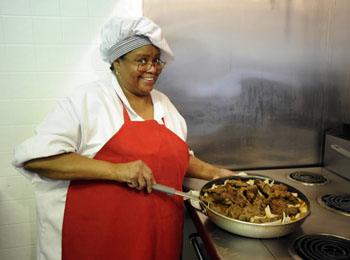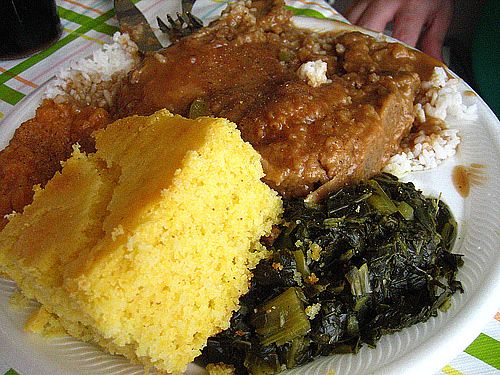Lifeline to a Soulful Culture
 Peoples of every culture, tribe, race, and nation partially define themselves by the foods they eat.
Peoples of every culture, tribe, race, and nation partially define themselves by the foods they eat.
by Stack Kenny
Cultural tradition and the history of generations are handed down through the ingredients and recipes of the food consumed by its people. We eat for sustenance and survival, but we also eat out of love; for taste and comfort, but also for the appreciation of sharing with each other one of life’s greatest gifts and necessities: good food!
The tradition of families and friends sharing communal meals has always been at the center of social unity and the perfect environment for relaxed conversations, the reciting of oral history and memories, storytelling, and hopeful discussions of plans for a brighter future. The importance of food throughout the African American community to help bring its people together past hardship and inequity finds its roots in the familiar term, “Soul Food.” And soulful it is!
Origins of a Cuisine
Soul food is an American cuisine. Although tracing its roots
back to pre-slavery West African culture, the name “soul food” actually
originated in the mid-1960s, with the explosion of a more modern
identity of black expression that came to light as the Civil Rights
Movement was burgeoning. Along with black power and soul music, African
Americans presented the foods and cooking styles carried down through
generations as “soul food.” Soon soul-food restaurants began to
reappear throughout the country, especially in major U.S. cities,
bringing the mostly rural family recipes to a wider public for the
first time.
In 1970, Verta Mae Grosvenor published Vibration Cooking and
gained notoriety for a successful show on PBS, where she cooked soul
food by “vibration” (also known as “dump-cooking”) rather than by the
precise measurements of ingredients. Although accenting the cuisine of
her beloved “Low Country” Gullah or Geechee culture, by instructing
cooks to “make do” with what was on hand, she captured the essence of
all African American cooking techniques.
But the origins of soul food come from West Africa. Before
slavery, most West Africans were farmers and brought seeds with them to
their newly forced homelands in the Americas. Many smuggled the seeds
in their beards, hair, or ears. Sesame, black-eyed peas, watermelon,
okra, and sorghum were all plants introduced to the “New World” via the
slave industry, and all eventually became commercial crops in America.
As slaves, African Americans had to improvise in the kitchen,
adding their native vegetables to the throwaway foods given to them
from plantation house kitchens. Soon Africans were developing recipes
for the discarded meats of the slave owners, learning how to make the
best of pig’s feet, beef tongue, ham hocks, chitterlings, pig ears, hog
jowls, and tripe. Many cooks also depended on catching wild meat and
game such as raccoon, possum, turtle, squirrel, and rabbit. To these
they added spices and vegetables, including the new greens they
discovered: collards, cress, mustard and poke-salad. All ingredients
were used out of necessity: whatever was available was useful, and
nothing was wasted.
Survival depended on the cooks maximizing the food at hand. When
slaves moved into the “big house” as cooks and servants, many cooks
became renowned for making “the best Southern food in the land” – small
compensation for one of the greatest injustices in world history.
After slavery ended in the United States, many poor African
Americans were forced to continue their meager cuisine, affording only
inexpensive or wild game meats and relying on vegetables, spices, and
the cook’s soul to give flavor and nutrition to a lowly diet. As time
passed, the soul food cooks’ repertoire also began to include the
influences of other cultures, most notably from Native Americans, who
introduced the many uses of corn, and from Creoles, who brought red
beans, rice, and shrimp into the mix. From this a tradition of food was
born that lives on to this day.
Soul Food and Health
Much has been written and discussed about the possible
negative health consequences of a diet based on soul-food ingredients.
Because of its traditional use of pork products, its accent on fried
meats, and liberal use of rendered pork fat into lard, soul food has
been criticized as adding to African Americans’ disproportionately high
rates of various diseases. But it must be remembered that these foods
were developed by enslaved Africans living under harsh and impoverished
conditions with grinding physical labor. It was not unusual for a slave
woman to have worked 14 to 16 hours in the field before cooking for her
family. The fats were needed for survival through the next day’s
unending labor.
Science has shown that frequent consumption of these fatty
foods, (without significant exercise and activity), can contribute to
high occurrences of obesity, hypertension, cardiac problems, diabetes,
and shortened lifespan. Yet health officials also acknowledge the high
value of consuming certain staples of soul food: collards are an
excellent source of vitamins and minerals; peas, rice, and legumes
offer an inexpensive source of protein; and sweet potatoes are known to
be on the top of the food pyramid as a source of beta carotene, and to
help stabilize blood sugar levels.
As contemporary African Americans have joined the rest of
America in embracing a sedentary lifestyle fueled by fast-food chains
and processed foods in the supermarket, perhaps it might be more
helpful to blame the inactivity produced by TV and computer games for
these health problems, and not the simple down-home unprocessed cooking
of soul food. To eat a plate of homemade fried chicken and collards
greens cooked with ham hocks satisfies the soul; the problem comes from
sitting down to the TV right afterwards and not moving the rest of the
evening. As with all cuisines and diets, perhaps the best advice is to
eat in moderation, and, for most heath problems, exercise!
Soul Food in 2009
Traditions are hard to erase. Recipes are handed down from
generation to generation through family cooks and adjusted for the
times with new ingredients and new cooking techniques. In many big
cities, soul-food restaurants still maintain a vital presence in the
African American community. In New York City, New York local attraction
tours offers a Jazz and Soul Food tour, cruising Harlem for the best
soul food and jazz still thriving in the Big Apple. In Chapel Hill, NC,
Mildred Council will celebrate the 33rd year of her successful and
renowned soul food restaurant, “Mama Dip’s.”
Unfortunately, here in the Asheville-Buncombe County area, after
losing the famous Rabbit’s on McDowell St., and the recent closing of
The Ritz on The Block, we have few “authentic” soul food restaurants to
please our palates. There are still institutions carrying out some soul
food traditions, especially with their “sides,” including Mama’s in
West Asheville and the new enterprise Happy Days on Patton Ave. One
Love II offers Jamaican soul food on The Block, and excellent down-home
food is cooked at Bubba’s Circle B Ranch BBQ up the street from the
Asheville airport in Fletcher. All bring a connection to the heritage
of cooking from scratch, and with a soul carried from historic
traditions.
Soul food is here to stay. Restaurants come and go, but the
value of a people’s heritage through food is just too important to let
go.
The recipes adapt and reemerge at church dinners,
Thanksgiving, Christmas, New Year’s Eve get-togethers with collards and
black-eyed peas, Fourth of July picnics, and Sunday family dinners.
There is still respect for the cook who uses no recipe but the one in
her mind that still holds a direct link to West Africa. There will
always be a love for the foods of your childhood, for food cooked with
love and care, for food prepared to sustain the pride of family and
community. And that is what you call Soul Food!
Recipe for Chitterlings (Chitlins)
Most families who love to cook chitlins have their own recipe passed
down through the generations. Chitlins (hog intestines) are not for the
feint of heart, (or smell), but are still popular in many communities,
especially at New Years and other holidays, and also known as a
cold-weather dish. Because they require great care in cleaning and
preparing, and have an intensive odor while cooking (if not cleaned
properly), very few restaurants offer the labor-intensive chitterlings
on their menu – thus chitlins has been left for families to continue
the tradition.
In the late 1950s and 60s, there was an informal string of juke
joints and clubs throughout the South known as the “Chitlin Circuit.”
This
was a series of music venues, usually serving soul food dinners, that
offered some of the greatest (segregated and by word of mouth only)
musicians of the era a chance to tour and perform for their fans. More
recently, the town of Salley, SC has inaugurated the annual Chitlin’
Strut. The festival draws 70,000 people and claims to have cooked
128,000 pounds of chitlins since its inception in 1996.
20 lbs. fresh or frozen chitterlings (thawed and properly cleaned of excess fat and grit)
Cold water to cover
1 cup cider vinegar
5 bay leaves
2 large onions, coarsely chopped
2 large potatoes, peeled and coarsely chopped
1 green or red sweet pepper, seeded and coarsely chopped
3 garlic cloves, minced
Salt and pepper to taste
Hot sauce
Pre-boil chitlins for five minutes and cool. Soak and rinse in
several changes of cold water. Clean and strip away as much fat as
possible from each piece and rinse in cold water again. Cut into small
1- to 2-inch pieces. Place cleaned chitlins in a heavy-duty large pot
and cover with water. Add remaining ingredients except hot sauce. Bring
to a boil, then lower heat and simmer on low for 2 ½ to 3 hours or
until chitterlings are tender. Drain well and serve with hot sauce and
more vinegar. Serves 6-8.
(Many health officials advise extreme care when handling
chitlins, due to the presence of the bacteria Yesinia, easily
contaminating and producing severe abdominal pain, especially in
children. It is recommended to pre-boil chitterlings for 30 minutes
before normal preparation and to take extra care washing utensils and
countertops afterwards).
 Mess O’ Collards or Mixed Salad Greens
Mess O’ Collards or Mixed Salad Greens
Every cook has a favorite unwritten recipe for these tasty,
nutritious greens. (You can also use smoked turkey instead of ham hocks
to season the pot, and cooking oil instead of bacon grease to sauté
onions.) Serve as a side with everything from pork chops and fried fish
to chicken wings and ribs.
3 lbs collard or salad greens (kale, mustard, turnip, spinach) leaves, rinsed
(for collards, cut into ½ inch strips)
1 smoked ham hock, 8-10 ounces (or smoked turkey parts)
1 large onion, coarsely chopped
4 garlic cloves, minced
3 Tbsp. bacon drippings (or non-pork cooking grease)
2 Tbsp. cider vinegar
1 Tbsp. sugar
½ tsps. crushed red pepper flakes
Salt and pepper to taste
Cook meat in a pressure cooker or medium pot with 2 cups of
water on medium heat for 45 minutes. Meanwhile sauté chopped onion in
bacon fat on medium heat until slightly brown, 8-10 minutes. Add garlic
and cook for another 3-4 minutes. Add sugar and seasonings and then
chopped collards. Cover with ½-cup of water, turn heat down low and
simmer. Add cooked ham hock and enough ham hock broth to keep collards
barely covered and cook until soft and tender, 40 minutes to an hour.
Fufu
Fufu was a dish prepared on the plantations by young girls learning
to prepare traditional foods. It was a simple one-pot meal made with
vegetables and pounded yams, often incorporating rice and ground nuts.
This is a more modern version based on the original idea.
1 large yam
1 egg
5 tsps. evaporated milk
1 small onion, grated
3 Tbsp. butter or margarine
Pinch of garlic salt
Salt and pepper to taste
Peel and cut yam into small pieces. Boil until tender in ½-cup water
for about 20 minutes. Drain and mash until smooth. Add egg, evaporated
milk, onion, and spices. Mix and roll into 2-inch balls. If mixture is
a little too wet, add a little flour. Fry in butter or margarine until
brown.
Stack Kenny is a writer, musician, and a national and international
Five-Star Chef who has creatively introduced his many clients and
restaurateurs to his exotic cuisines and culturally tasteful dishes.








